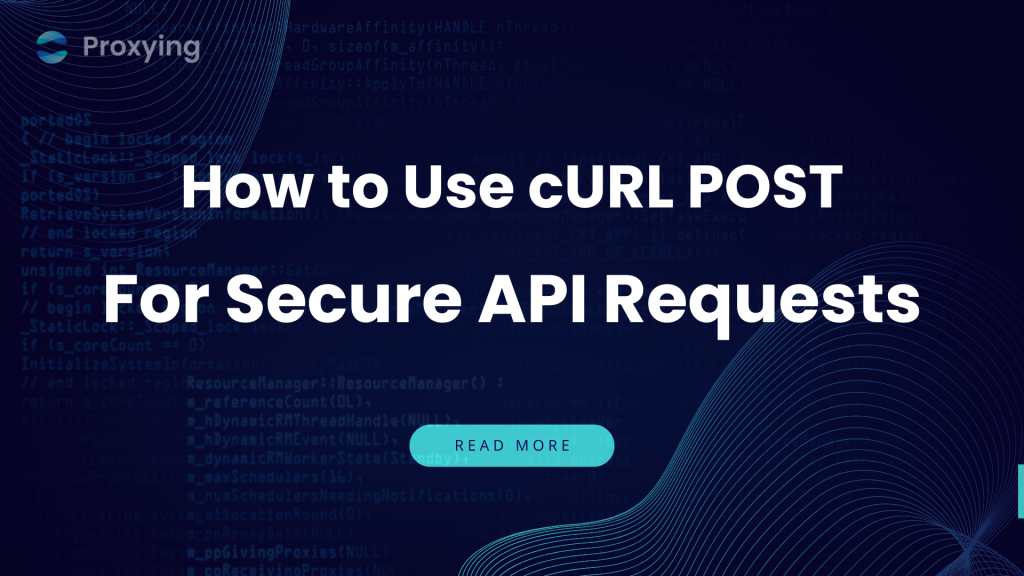Are you ready to use the strength of cURL GET requests to pull information from the internet? Whether you’re scraping a site, testing an API, or just curious, cURL is your go-to tool. In this tutorial, I will guide you through what a cURL GET request entails, how to execute them, as well as how to supercharge them using Proxying.io proxies to efficiently query the data.
What’s a cURL GET Request?
Imagine yourself asking a website,” Hey, can you send some of your data?” That’s essentially what a cURL GET request does.
cURL (Client URL) is a command-line tool that lets you interact with a web server, and a GET request is the easiest method to retrieve data, such as a webpage itself, an API response, or a file without making any modifications to the server. It is just like window-shopping, you look, you take, you move on. You will be operating cURL in your terminal.
It comes installed with most systems, but if it’s not, then see how to use cURL with a proxy.
Basic cURL GET Request
Open your terminal and try this:
curl https://api.example.com/dataThis makes a GET request to api.example.com/data. In case it’s a public API, you will see a response such as JSON data will be data popping up in your terminal.
Remember: Replace username, password, and port with your Proxying.io credentials.
{"message": "Hello, world!"}Yet what about when you want to be more precise? You can add query parameters to filter results. Suppose you are requesting an API for a weather forecast.
curl https://api.weather.com/v3/forecast?city=NewYork&apiKey=your_keyHere, city = NewYork and apiKey = your_key are query parameters that tell the server exactly what you want.

Headers and Customizations
Sometimes servers require additional information, such as who you are, how you are, or how much data you wish to be provided. That is where the headers come in. Add them using -H flag. For instance, to request JSON data:
curl -H "Accept: application/json" https://api.example.com/dataNeed authentication? Many APIs require an API key in the header:
curl -H "Authorization: Bearer your_token" https://api.example.com/secure-dataYou can also save the response to a file with -o:
curl -o output.json https://api.example.com/dataNow output.json has your data, ready for you to analyze or share.
Remember: Replace username, password, and port with your Proxying.io credentials.
Using Proxies for Smarter Requests
When scraping sites such as r/technology on Reddit or calling APIs at scale, you can hit rate limits or be blocked. The proxies will help you make your cURL requests, then such requests will be routed by the proxies with different IPs, making this request anonymous and eluding limits.
To use a Proxying.io proxy, add the --proxy option.
curl --proxy http://username:password@proxy.proxying.io:port https://api.example.com/dataRemember: Replace username, password, and port with your Proxying.io credentials.
What Makes Residential Proxies a Better Choice
They use real user IPs, making your requests look legit and reducing the chance of blocks. Perfect for scraping or testing geo-restricted content.
Handling Common Issues
You might run into some issues. Here are 3 common ones + their solution!
- Connection errors: Check your URL or internet connection. If you’re using a proxy, ensure your Proxying.io credentials are correct.
- Rate limits: Switch IPs with Proxying.io’s rotating proxies to keep requests flowing.
- JSON parsing: If the output is messy, pipe it to jq for cleaner formatting:
curl https://api.example.com/data | jq ..cURL GET Request Arguments
cURL’s flexibility shines with its command-line options. Here are the key ones for GET requests:
- Headers Only (-I,
--head): Retrieve only HTTP headers:
curl -I https://api.example.com/data- Include Headers (-i,
--include): Display headers with the response:
curl -i https://api.example.com/data- Custom Header (-H,
--header): Specify headers, like requesting JSON:
curl -A "Mozilla/5.0" https://api.example.com/data- User Agent (-A,
--user-agent): Set a custom User-Agent:
curl -A "Mozilla/5.0" https://api.example.com/data- Cookies (-b,
--cookie): Send cookies:
curl -b "name=value;another=anotherval" https://api.example.com/data- Output to File (-o,
--output): Save the response:
curl -o output.json https://api.example.com/data- Verbose Mode (-v,
--verbose): Get detailed request info:
curl -v https://api.example.com/data- Silent Mode (-s,
--silent): Suppress output for scripting:
curl -s https://api.example.com/dataRemember: Replace username, password, and port with your Proxying.io credentials.
Advanced cURL Techniques
- Verbose mode: Add -v to see detailed request info, great for debugging:
curl -v https://api.example.com/data- Follow redirects: Some sites redirect you. Use -L to follow them:
curl -L https://example.com- Combine with Proxying.io: For heavy scraping, use Proxying.io’s proxy pools to rotate IPs automatically, keeping your requests smooth and unblocked.
Remember: Replace username, password, and port with your Proxying.io credentials.
Conclusion
With the insights from this guide, you’re now equipped to perform cURL GET requests effectively, whether for simple data retrieval or complex proxy-driven tasks. From querying APIs to building automation workflows, you can retrieve data with speed and reliability.




